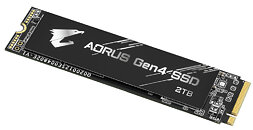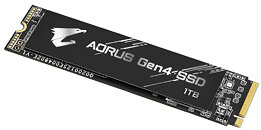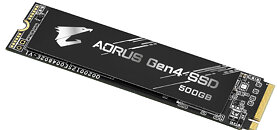Monday, July 27th 2020

GIGABYTE Announces AORUS Gen4 SSD Series without Heatsinks
GIGABYTE was among the first to the market with a PCI-Express gen 4.0 M.2 NVMe SSD, with its AORUS NVMe Gen4 SSD series from June 2019. Those drives are characterized by bulky copper heatsinks. The company decided to launch variants of the drive that lack this heatsink, and instead using only a thin copper peel that works both as a heatspreader and as a product label. The rationale behind this product is to let people use the M.2 heatsink that came with their motherboards. The lineup consists of 1 TB (GP-AG41TB) and 2 TB (GP-AG42TB) variants, and introduces a new 500 GB variant (GP-AG4500G) that's not available in the original lineup.
The underlying drive is identical. It combines a Phison PS5016-E16 controller with 96-layer 3D TLC NAND flash memory over 8 channels, and a DDR4 DRAM cache (512 MB for the 500 GB variant, 1 GB for the 1 TB variant, and 2 GB for the 2 TB variant). All three variants offer sequential read speeds of up to 5000 MB/s. The 1 TB and 2 TB variants offer up to 4400 MB/s sequential writes, while the 500 GB variant offers up to 2500 MB/s. The 1 TB and 2 TB variants further offer the same 4K random-access performance numbers of 750k/700k IOPS (reads/writes), while the 500 GB variant offers up to 400k/550k IOPS. GIGABYTE is backing the drives with 5-year product warranties. The company didn't reveal pricing.
The underlying drive is identical. It combines a Phison PS5016-E16 controller with 96-layer 3D TLC NAND flash memory over 8 channels, and a DDR4 DRAM cache (512 MB for the 500 GB variant, 1 GB for the 1 TB variant, and 2 GB for the 2 TB variant). All three variants offer sequential read speeds of up to 5000 MB/s. The 1 TB and 2 TB variants offer up to 4400 MB/s sequential writes, while the 500 GB variant offers up to 2500 MB/s. The 1 TB and 2 TB variants further offer the same 4K random-access performance numbers of 750k/700k IOPS (reads/writes), while the 500 GB variant offers up to 400k/550k IOPS. GIGABYTE is backing the drives with 5-year product warranties. The company didn't reveal pricing.




8 Comments on GIGABYTE Announces AORUS Gen4 SSD Series without Heatsinks
The 2TB isn't worth it imo. Out of that you get like 1.8 usable storage + you have to keep like 300 GB unused so it would run at maximum frequency. So you are left with 1.5, meh. Windows, few games and a download folder.
Maybe you all would have more space if you stopped this additional overprovisioning nonsense and keeping an exhorbinant amount of extra free space.